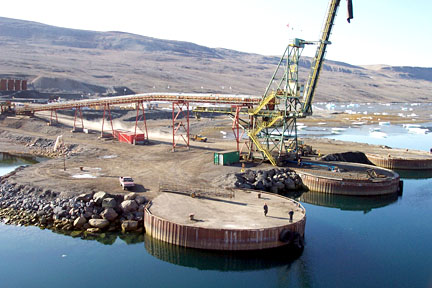Nanisivik: Nunavut’s incredible shrinking naval facility
“A significant reduction of the site layout and function plan”

The old port at Nanisivik, as seen in a 2005 file photo. The Department of National Defence quietly revealed big cutbacks to a 2007 scheme that would have seen a $100-million upgrade to the old facility. (FILE PHOTO)
Prime Minister Stephen Harper’s much-ballyhooed plan to build a naval facility at Nanisivik shrunk dramatically last month, when Department of National Defence officials told regulators about big cutbacks to the project.
“The planned changes result in a significant reduction of the site layout and function plan that was submitted for review in 2011,” DND’s project manager, Rodney Watson, said in a Feb. 24 letter to the Nunavut Impact Review Board, which is now screening the project.
Under DND’s new scheme, the Nanisivik naval facility would become a part-time summer-only gas station for Ottawa’s proposed fleet of Arctic offshore patrol ships, along with other federal government vessels.
“The facility will only be operational during the navigable (summer) season. All facilities will be shut down and secured when not in use.On-site support will likely be reduced to an as-needed basis,” Watson said.
Under the original plan, which Harper announced Aug. 10, 2007 during a northern tour, Ottawa would have spent $100 million on a major upgrade to the old dock once used by Breakwater Resources Ltd. for shipping ore out of its now-defunct Nanisivik lead-zinc mine.
“With its sheltered harbour, nearby jet-capable airstrip, and proximity to the Northwest Passage, Nanisivik offers an ideal location for the docking and refuelling facility,” a 2007 federal government backgrounder document bragged.
But the “jet-capable” airstrip at Nanisivik is now history, replaced by a new gravel runway and small airport at Arctic Bay, built by the Government of Nunavut.
That means DND will continue to gain access to the site either through the overland road from Arctic Bay or the existing deep-water berth.
Ottawa will now store only one year’s supply of fuel at the site, which means a smaller tank farm and fewer storage tanks.
And because the shrunken project will not require electrical power all year round, the site will require less diesel to fuel generators, which will operate only when the site is occupied.
DND will axe all permanent accommodations for personnel and will use “existing DND trailers” for those brief periods when the site is used for refueling government vessels.
To supply water and remove waste from the site, it appears as if the federal government will need help from the Hamlet of Arctic Bay.
“The trailers will require support from the local community for potable water and wastewater management,” Watson’s letter said.
Human waste and garbage will be put into sealift containers and “shipped off-site to an approved disposal facility at the end of each season.”
DND is cutting plans to install a telecommunications system, saying staff can use handheld radios and satellite phones instead.
They will retain a “large flat area” for use as a helicopter landing pad, but it will meet DND’s code requirements only if “budget permits.”
It’s not clear how much money Ottawa will save through the Nanisivik cutbacks.
But Watson said “a detailed design is not yet available, as these changes have just recently been determined.”
The facility would continue to serve as a refueling base for a $3.1 billion fleet of Arctic offshore patrol ships that Harper also announced in 2007.
Ottawa planned to have the facility up and running by 2013, but that’s been delayed until at least 2016.
Meanwhile, the revised Nanisivik project sits at the impact review board’s screening stage, awaiting comment from a long list of stakeholders.





(0) Comments